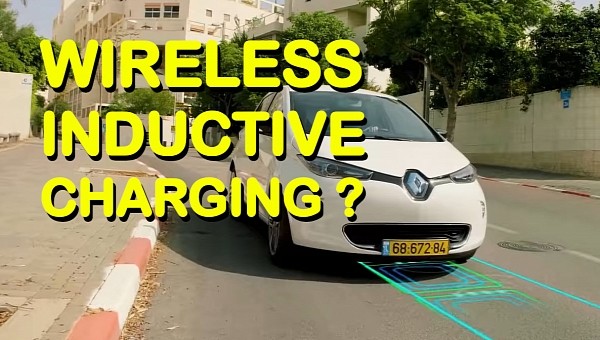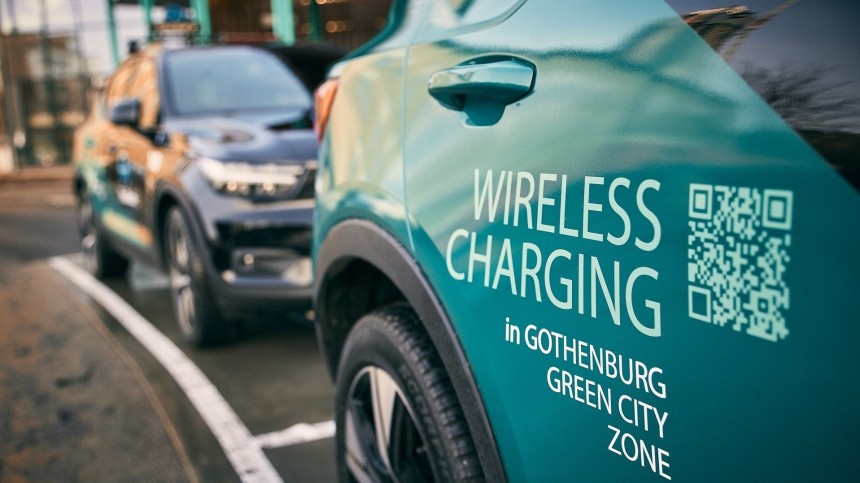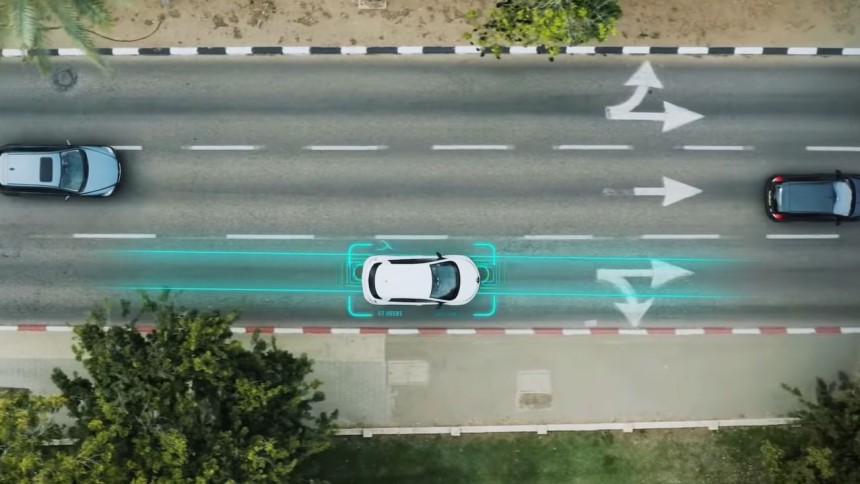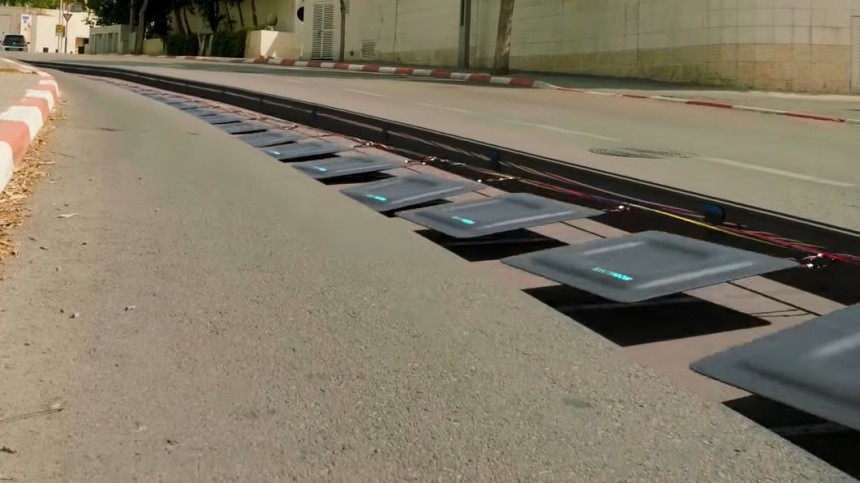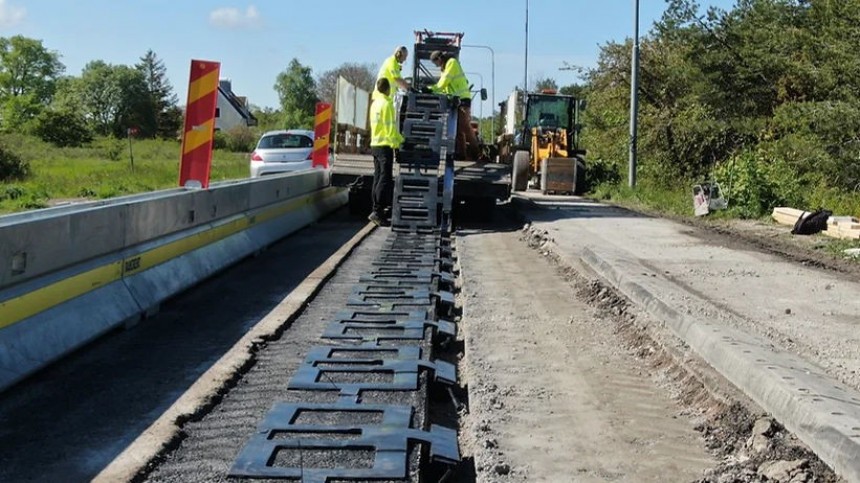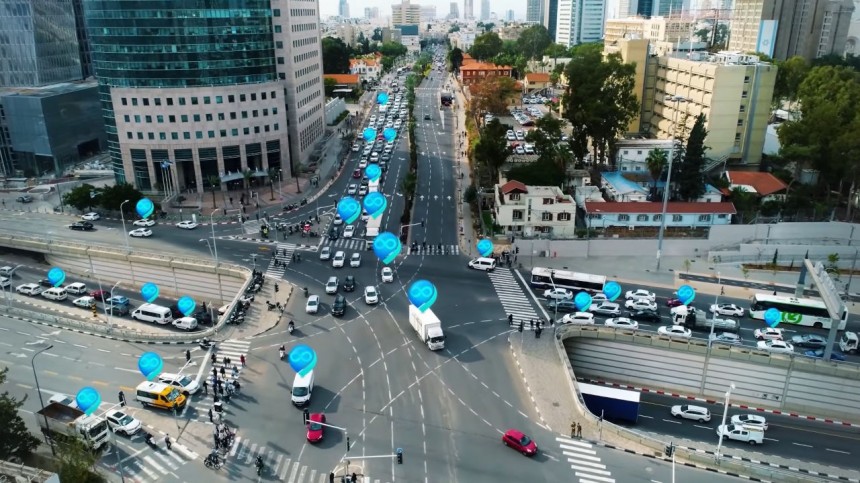In the first two parts of this series, we briefly looked at battery-swapping technology and conductive charging using pantographs or electric rails. They both have pros and cons, but in the near future, the disadvantages seem to weigh more. The wireless inductive charging looks very promising as well, so let’s see if it’s the winning lottery ticket for future EVs.
We started this three-part debate based on what today’s drivers see as ease of use for their internal combustion cars. Filling up the tank in a matter of minutes and driving long-range distances with no worries is the basis for peace of mind.
Currently, electric cars and SUVs are plagued by long battery charging times and poor range between charging. At least, this is what popular wisdom has been promoting throughout the years. The industry tried to find alternatives to plug-in charging to overcome the 'range anxiety' obstacle and time-related issues.
We’ve seen that China is investing big into battery swapping technology, which sort of mirrors the gas station convenience. Other companies are pursuing wireless conductive charging, copying the rail electrification, with pantographs and in-road electric rails.
However, all these stumble upon technical and standardization hurdles that, unfortunately, overcome their convincing advantages. At least for the rest of this decade. A third alternative is wireless inductive charging. Let’s see its pros and cons.
Swapping batteries is done automatically in the special station. That’s great, but replacing batteries over and over again puts some big stress on connecting electronics. Besides, if the battery is not part of the car structure, it can negatively impact its rigidity in time.
Using conductive charging means the battery and the connecting electronics stay in their place. Besides, it proved its reliability in rail transport, as well as in public transport. The overhead pantograph or the underneath mobile arm must be all the time in touch with the wires and the electric rail, respectively.
This is possible at low speeds, but the dynamics of the vehicle are ever-changing. And don’t forget the intensive wear in time because of high voltage currents transmitted through the pantographs and rail arms.
That’s why plug-in charging is still considered a better and safer option for battery swapping or conductive charging in the long run. At least, this is what most carmakers agree with today. They also agree that wireless charging is potentially game-changing.
From a technical point of view, having no contact between connectors whatsoever increases the components’ reliability. It also could simplify the whole charging network design and reduce complexity. Oh, and it really is what the customer expects: not moving a finger to charge their EV.
They say, “seeing is believing,” but you can’t see this phenomenon. Maybe that’s why even today many think it’s magic, and there are a few who fear witchcraft. In fact, ‘magic’ has a name: electromagnetic induction. It’s simple physics, so let’s briefly recap if you missed that school lesson.
When the electricity travels through a wire, it also creates a magnetic field around it. If you’ve got a coil, the magnetic field intensity is higher, and its field lines go further in space. When you put another coil near the first one, without touching it, the magnetic field simply creates a current in the second coil.
It’s worth noting the main difference between inductive charging and conductive charging, although both are labeled as ’wireless charging.’ Inductive charging means no contact between devices, and that’s why it’s considered “the real wireless charging.”
Wireless charging for electric cars is much older than you think. The first method was developed in the 1890s, almost 130 years ago! But real developments began only in the 1970s. The first application for an electric vehicle was a system capable of charging with a power of 20 kW, which was pretty much half a century ago.
In the 2000s, MIT made a major step forward in inductive charging by using something named resonant coupling. It’s too complicated for basic physics, but in the following years, various organizations formed to create international standards for wireless charging usage.
Consulting company Markets&Markets projects that the global wireless charging market for EVs will grow from $15 million (€14.2 million) in 2022 to more than $350 million (€330 million) by 2027. This is an 80% increase in 5 years, and this signals lots of opportunities.
For now, the average cost of a wireless charger is $2,500-3,000 (€2,300-2,800) higher than a plug-in one. Fitting the corresponding equipment underneath the car adds several hundreds of dollars or even more than one thousand.
As the competition will drive down the costs, many analysts believe that in-cities AC charging networks, along with home and office charging will convert to wireless charging devices in just a few years. The low-power 3 to 11 kW wireless charging is expected to become the norm for batteries up to 40-50 kWh.
What about fast charging? In 2018, researchers at the Department of Energy’s Oak Ridge National Laboratory demonstrated a 120-kilowatt wireless charging system. It was a lab experiment, but it opened the gates to a wireless fast-charging race.
By the way, the same ORNL demonstrated that wireless charging is suitable for high SUVs and pickup trucks, but also for vehicle-to-grid applications. Their most recent system is a unique polyphase electromagnetic coil that delivers the highest surface power density available.
It can feed up to 1.5 MW per square meter of electricity without the need for cables. This way, it enables very fast wireless charging. While it’s in the development stage, it has the potential to charge vehicles in motion at highway speed. Does it sound like a game-changer or what?
One of the main advantages of a wireless charging network embedded in roads, highways, and parking lots is that cars don’t need bigger batteries anymore. Wherever you go and wherever you park, there’s energy feeding the electric motor of the car.
For instance, a giant Hummer EV1 packing a more than 200 kWh battery today would simply need a battery ten times smaller, like those used in plug-in hybrids. Likewise, there would be no need for ultra-fast-charging networks anymore, because wireless charging means unlimited range.
Of course, this is a very optimistic scenario because Hummer EV1 is an offroader, and wireless charging is hardly feasible in the wildness. But for 90% of the electric cars and SUVs is a workable scenario. And don’t forget heavy-duty vehicles, like trucks and buses.
In the last years, several companies have been very busy running pilot projects and trials. In 2020, Israel-based Electreon launched the first wireless electric road system for trucks and buses on public roads. The Smartroad Gotland project used a fully electric 40-ton truck and trailer on a 1-mile (1.6 km) stretch of ‘electric road.’
It consisted of copper coils buried 8 cm (3.1 in.) below the roadway, while the truck was fitted with five 20-kW receivers, with an efficiency of about 90% each. In the following years, the demonstration project added a commercial electric airport bus, and the charging infrastructure was upgraded to new versions.
In the meantime, the company partnered with the American association ASPIRE to launch an electrified roadway demonstration joint project in Utah. And it successfully completed the “Arena of the Future” trial in Italy, a pilot project in partnership with Stellantis.
The ‘cure’ could come from the German startup Magment, which developed a so-called magnetizable concrete, created from cement and recycled magnetic particles. It will be used in “the first contactless wireless-charging concrete pavement highway segment” in Indiana, in a joint project of the Department of Transportation and Purdue University.
The cost is also an issue. Initial calculations show that an in-road wireless charging network would be at least 50% more expensive than a plug-in fast-charging stations network servicing the same number of electric vehicles.
Of course, calculations don’t take into account emission and cost savings because of the smaller batteries needed by electric vehicles. There’s also a convenience cost that can’t be evaluated yet, although “time is money” is a good starting point.
We cannot ignore the problem of the alignment between the two coils, the one in the road and the one underneath the vehicle. If the alignment is not perfect, the efficiency drops by a large margin, and it translates to energy losses or lower speeds for the vehicle.
The easiest solution is to let the car’s computer deal with alignment, which is fairly easy for the nearly self-driving systems. And this gets us to the biggest elephant in the room: the interdependency of autonomous electric vehicles and wireless charging.
While they are far from being ‘zero-emissions’, electric vehicles are already halving the emissions and pollutants caused by internal combustion engines. Add to the equation the self-driving technology gains in efficiency, and here you are – slashing emissions to almost zero is possible.
You don’t have to be a genius to understand that wireless charging is the missing link for a self-driving global fleet. Maybe robots could deal with filling up tanks, either with petroleum fuels, or hydrogen and e-fuels. But this is far more complicated than a wireless charging network.
Likewise, swapping batteries is competitive only when compared to classic plug-in charging stations. When wireless charging comes into the picture, battery swap becomes simply obsolete. Or complementary at most.
Finally, conductive charging is an interesting option, but it’s less attractive than inductive charging because of more complexity and all those parts that need to be in contact. The main advantage of wireless charging is its universal compatibility with any standardization.
In a perfect world, self-driving vehicles powered by a wireless charging network are the best-case scenario. I know it’s still a sci-fi scenario for now. It’s not an easy task to foresee the future, but this is what industry and policymakers are forced to do.
Because the solutions we choose to fund today are shaping the future world’s sustainability, and ultimately, will decide our society’s fate. So, don’t be surprised if you see a focus shift to these two technologies by the end of this decade.
It will simply mean that “The fittest survive” Darwinian principle will prevail. And this is good news for future generations, despite the reluctance of many of today’s generations. But, hey, there’s never been an easy way for evolution on this planet. Get used to it.
Currently, electric cars and SUVs are plagued by long battery charging times and poor range between charging. At least, this is what popular wisdom has been promoting throughout the years. The industry tried to find alternatives to plug-in charging to overcome the 'range anxiety' obstacle and time-related issues.
We’ve seen that China is investing big into battery swapping technology, which sort of mirrors the gas station convenience. Other companies are pursuing wireless conductive charging, copying the rail electrification, with pantographs and in-road electric rails.
However, all these stumble upon technical and standardization hurdles that, unfortunately, overcome their convincing advantages. At least for the rest of this decade. A third alternative is wireless inductive charging. Let’s see its pros and cons.
Not touching anything is already a leap
To fill up the tank, you have to open the gas cap, take the fuel nozzle, and put it in for the liquid to flow to the tank. You can do it “wireless” only if someone else is doing this for you. So, not having to touch anything for your car to be ready to go is a strong selling point.Swapping batteries is done automatically in the special station. That’s great, but replacing batteries over and over again puts some big stress on connecting electronics. Besides, if the battery is not part of the car structure, it can negatively impact its rigidity in time.
Using conductive charging means the battery and the connecting electronics stay in their place. Besides, it proved its reliability in rail transport, as well as in public transport. The overhead pantograph or the underneath mobile arm must be all the time in touch with the wires and the electric rail, respectively.
This is possible at low speeds, but the dynamics of the vehicle are ever-changing. And don’t forget the intensive wear in time because of high voltage currents transmitted through the pantographs and rail arms.
From a technical point of view, having no contact between connectors whatsoever increases the components’ reliability. It also could simplify the whole charging network design and reduce complexity. Oh, and it really is what the customer expects: not moving a finger to charge their EV.
It's a kind of magic. Until it’s not
What is this wireless inductive charging, anyway? Interestingly, it was discovered over a century ago, but history mainly remembers Nikola Tesla’s experiments in this field. His famous Wardenclyffe 185-foot tower is already subject to many urban stories and conspiracies.They say, “seeing is believing,” but you can’t see this phenomenon. Maybe that’s why even today many think it’s magic, and there are a few who fear witchcraft. In fact, ‘magic’ has a name: electromagnetic induction. It’s simple physics, so let’s briefly recap if you missed that school lesson.
When the electricity travels through a wire, it also creates a magnetic field around it. If you’ve got a coil, the magnetic field intensity is higher, and its field lines go further in space. When you put another coil near the first one, without touching it, the magnetic field simply creates a current in the second coil.
Wireless charging for electric cars is much older than you think. The first method was developed in the 1890s, almost 130 years ago! But real developments began only in the 1970s. The first application for an electric vehicle was a system capable of charging with a power of 20 kW, which was pretty much half a century ago.
In the 2000s, MIT made a major step forward in inductive charging by using something named resonant coupling. It’s too complicated for basic physics, but in the following years, various organizations formed to create international standards for wireless charging usage.
Wireless charging of EVs while they’re parked
Today, wireless charging has become mainstream in smartphones. It seems on the way to becoming a big thing in the car industry as well because, in 2020, the SAE J2954 standard was published. After more than a decade in the making, it finally specifies the requirements for wireless charging of EVs.Consulting company Markets&Markets projects that the global wireless charging market for EVs will grow from $15 million (€14.2 million) in 2022 to more than $350 million (€330 million) by 2027. This is an 80% increase in 5 years, and this signals lots of opportunities.
For now, the average cost of a wireless charger is $2,500-3,000 (€2,300-2,800) higher than a plug-in one. Fitting the corresponding equipment underneath the car adds several hundreds of dollars or even more than one thousand.
As the competition will drive down the costs, many analysts believe that in-cities AC charging networks, along with home and office charging will convert to wireless charging devices in just a few years. The low-power 3 to 11 kW wireless charging is expected to become the norm for batteries up to 40-50 kWh.
By the way, the same ORNL demonstrated that wireless charging is suitable for high SUVs and pickup trucks, but also for vehicle-to-grid applications. Their most recent system is a unique polyphase electromagnetic coil that delivers the highest surface power density available.
It can feed up to 1.5 MW per square meter of electricity without the need for cables. This way, it enables very fast wireless charging. While it’s in the development stage, it has the potential to charge vehicles in motion at highway speed. Does it sound like a game-changer or what?
Charging your car while on the move is not sci-fi anymore
Conductive charging solution for moving vehicles implies all sorts of devices to make contact with overhead electrical lines or in-road electric rail. Inductive charging makes things simpler, and the ‘rail’ can be hidden under the asphalt.One of the main advantages of a wireless charging network embedded in roads, highways, and parking lots is that cars don’t need bigger batteries anymore. Wherever you go and wherever you park, there’s energy feeding the electric motor of the car.
Of course, this is a very optimistic scenario because Hummer EV1 is an offroader, and wireless charging is hardly feasible in the wildness. But for 90% of the electric cars and SUVs is a workable scenario. And don’t forget heavy-duty vehicles, like trucks and buses.
In the last years, several companies have been very busy running pilot projects and trials. In 2020, Israel-based Electreon launched the first wireless electric road system for trucks and buses on public roads. The Smartroad Gotland project used a fully electric 40-ton truck and trailer on a 1-mile (1.6 km) stretch of ‘electric road.’
It consisted of copper coils buried 8 cm (3.1 in.) below the roadway, while the truck was fitted with five 20-kW receivers, with an efficiency of about 90% each. In the following years, the demonstration project added a commercial electric airport bus, and the charging infrastructure was upgraded to new versions.
In the meantime, the company partnered with the American association ASPIRE to launch an electrified roadway demonstration joint project in Utah. And it successfully completed the “Arena of the Future” trial in Italy, a pilot project in partnership with Stellantis.
Sorry, but wireless charging is just not there yet
While the tests are very promising in terms of vehicle efficiency, there are still hurdles related mainly to road construction endurance. Installing the coils under the asphalt is not an easy task, and the lifetime of such a system is estimated to be only 5 to 7 years with current technologies.The ‘cure’ could come from the German startup Magment, which developed a so-called magnetizable concrete, created from cement and recycled magnetic particles. It will be used in “the first contactless wireless-charging concrete pavement highway segment” in Indiana, in a joint project of the Department of Transportation and Purdue University.
Of course, calculations don’t take into account emission and cost savings because of the smaller batteries needed by electric vehicles. There’s also a convenience cost that can’t be evaluated yet, although “time is money” is a good starting point.
We cannot ignore the problem of the alignment between the two coils, the one in the road and the one underneath the vehicle. If the alignment is not perfect, the efficiency drops by a large margin, and it translates to energy losses or lower speeds for the vehicle.
The easiest solution is to let the car’s computer deal with alignment, which is fairly easy for the nearly self-driving systems. And this gets us to the biggest elephant in the room: the interdependency of autonomous electric vehicles and wireless charging.
The future is both wireless and autonomous
The worst-kept secret of Big Auto is they want to replace drivers with robots. At least this is the favorite conspiracy related to self-driving cars. Autonomous vehicles’ main purpose is to increase efficiency and lower road fatalities. It’s just engineering common sense.While they are far from being ‘zero-emissions’, electric vehicles are already halving the emissions and pollutants caused by internal combustion engines. Add to the equation the self-driving technology gains in efficiency, and here you are – slashing emissions to almost zero is possible.
Likewise, swapping batteries is competitive only when compared to classic plug-in charging stations. When wireless charging comes into the picture, battery swap becomes simply obsolete. Or complementary at most.
Finally, conductive charging is an interesting option, but it’s less attractive than inductive charging because of more complexity and all those parts that need to be in contact. The main advantage of wireless charging is its universal compatibility with any standardization.
In a perfect world, self-driving vehicles powered by a wireless charging network are the best-case scenario. I know it’s still a sci-fi scenario for now. It’s not an easy task to foresee the future, but this is what industry and policymakers are forced to do.
Because the solutions we choose to fund today are shaping the future world’s sustainability, and ultimately, will decide our society’s fate. So, don’t be surprised if you see a focus shift to these two technologies by the end of this decade.
It will simply mean that “The fittest survive” Darwinian principle will prevail. And this is good news for future generations, despite the reluctance of many of today’s generations. But, hey, there’s never been an easy way for evolution on this planet. Get used to it.
